As an online retailer, you already know that returns happen — a lot — and it’s impossible to please every customer.
But did you know that consumers abandon their digital shopping carts 69% of the time? And that 12% of those cited an unsatisfactory return policy as the reason?
Posting a thorough return policy can help you reduce that percentage and retain more customers.
Our refund and return policy template is free and helps businesses like yours display a comprehensive, easy-to-read policy in just a few clicks.
Below we’ll go over why you need a return policy, show you some examples, and provide you with a free return policy template download to set your business up for success.
If you’re short on time, build one for free with our return policy generator instead.
- What Is a Return Policy?
- Who Needs a Return Policy?
- Benefits of Having a Return and Refund Policy
- What Your Return Policy Should Include
- Where to Display Your Return Policy
- Tips To Make the Most of Your Return and Refund Policy
- Return Policy Examples
- Return Policy FAQ
- Standard Return & Refund Policy Template (Free Download)
- Summary
What Is a Return Policy?
A return policy outlines how, when, and under what conditions your customers can return purchased goods and services.
You can name your return policy in many different ways, such as:
- Return and refund policy
- Returns and exchange policy
- Shipping and return Policy
- Store Return Policy
A well-written return policy can help your business retain customers and increase sales. But overly restrictive or nonexistent policies tend to scare people away.
What Is a Refund Policy?
A refund policy is a document that outlines the rules for getting refunds for purchased goods and services. It often details the eligibility requirements for refunds, types of refunds given, the refund timeframe, and the return process.
Is There a Difference Between a Return Policy and Refund Policy?
Returns and refunds are technically two separate occurrences.
A return policy indicates rules and conditions about if, when, and for how long your customers can return a purchase and receive reimbursement. It includes information about how long your customer has to make the return and which items are included or excluded from the policy.
A refund policy states if and when your customers are entitled to receive reimbursement for a purchase and do not have to be contingent on a return. For example, if a customer received a faulty or damaged item, or if the order never arrives, your refund policy should stipulate if the customer is entitled to receive a refund.
What About Exchange Policies?
You also have the option to set up an exchange policy with your customers. Exchange policies outline if your customer can request store credit, a replacement item, or a new item of the same or lesser value instead of a refund.
It’s up to you if your business requires a single policy outlining all guidelines for returns, refunds, and exchanges or if you want to separate them into three individual documents.
Most online businesses outline these customer services within a single policy and use return, refund, and exchange clauses so customers can easily locate the rules for each process.
But a specialty or small business return policy, exchange policy, and refund policy might end up longer than average, so separating them might be the best option for you.
Either way, our free refund and return policy template is fully customizable to suit your unique business needs.
Check out and share our helpful return policy inforgraphic:

Who Needs a Return Policy?
Anyone directly selling goods or services to consumers online or in person needs a return policy, including:
- Small businesses
- Ecommerce websites
- Retail stores
- Dropshipping companies
- Software as a Service (SaaS) businesses
Your competitors, no doubt, already offer refunds, returns, and exchanges. This is a common practice, and customers will probably choose a competitor with a good return policy over your business if you don’t provide one.
Ecommerce Return Stats and Facts
As the digital marketplace continues to grow, more and more customers choose to shop online. With this comes an increased percentage of returns, exchanges, and refunds.
Below, see some recent statistics from the National Retail Federation (NRF) to learn how this impacts businesses like yours.
- $761 billion – total sales US retailers lost to returns in 2021
- 20.8% of sales from online merchandise were returned
- 10.6% of online returns were fraudulent
According to the survey, the following retail categories had the highest return rates:
- Auto parts: 19.4%
- Apparel: 12.2%
- Home improvement: 11.5%
- Housewares: 11.5%
- Department stores: 11.4%
- Footwear: 9.1%
- Sporting goods: 7.6%
- Beauty: 4.3%
No matter what industry your business is part of, you should expect your customers to request returns, exchanges, or refunds.
Embedding a comprehensive return policy with refund and exchange clauses on your website helps protect your business from fraudulent returns and increases trust between you and your consumers.
Are You Legally Required To Have a Return Policy?
While you are not legally required to have a return policy, laws and regulations about a customer’s right to a refund do exist in certain situations around the world.
For example, if you sell to consumers in the UK or throughout Europe, refunds are legally required if an item is:
- Faulty
- Not as described
- Does not perform as promised
On the other hand, Australia, the US, and Canada do not require businesses to provide returns on any goods.
However, some US states have regulations in place mandating that you post a conspicuous policy if you intend to refuse refunds. If you do not post a policy stating otherwise, the consumer is entitled to a refund within various time limits and with proof of purchase.
Take a look at those state requirements in the table below.
| State | Requirement | Source |
| California | If a store displays a limited or no-refund policy, refunds and exchanges are not required by law. | State of California Department of Justice |
| Connecticut | If no notice is posted, you may return any new, unused item within 7 calendar days with proof of purchase for a refund. | Connecticut State Department of Consumer Protection |
| Florida | Establishments offering goods for sale with a no cash refund, no credit refund, or no exchange of merchandise must post a sign stating so at the point of sale. Failure to do so means a refund or exchange policy exists. | The Florida Senate |
| Hawaii | If no conspicuous sign is posted, the law requires merchants to accept the return of goods and provide a refund. | State of Hawaii Department of Commerce and Consumer Affairs |
| Maryland | Stores must post return policies on the wall, merchandise, or receipt. If one is not posted, the store must accept returned merchandise within a reasonable period. | Maryland Attorney General |
| Massachusetts | A store can have any return policy they want as long as it’s clearly disclosed somewhere in the store and the consumer can read it before purchasing. Otherwise, a refund is assumed. | Mass.gov |
| Minnesota | Cash refunds cannot be refused for acceptable goods unless notice of the seller’s refund policy is clearly and conspicuously displayed in a minimum of type 14 point font. | Minnesota Legislature Office of the Revisor of Statutes |
| New Jersey | Refund policies that are 20 days or less (including no-refund policies) must be conspicuously displayed by merchants and clearly visible to shoppers before making a purchase. | The State of New Jersey Office of the Attorney General |
| New York | Stores are legally required to post their refund policy. Without one, stores are required to accept returns within 30 days of purchase. | New York Department of State |
| Ohio | If the seller does not post a refund policy, the consumer is entitled to a refund if they request one. | Ohio Attorney General |
| Rhode Island | Customers have 10 business days from the date of purchase for a refund in the same manner as paid in an equivalent amount at the time of sale unless the customer has been clearly informed at the point of display or the cash register that all sales are final or that merchandise is not returnable. | State of Rhode Island Attorney General |
| Utah | Under the Utah Consumer Sales Practices Act, Rule 11, it’s considered a deceptive practice to refuse a return if the consumer can provide reasonable proof of purchase from the supplier unless a sign is posted at the point of display, sale, or store entrance. | Utah Office of Administrative Rules |
| Virginia | Failing to disclose all conditions, charges, or fees relating to the return of goods is considered unlawful under the Virginia Consumer Protection Act. | Virginia Consumer Protection Act |
Are Return Policies Legally Binding?
Return policies are legally binding in some parts of the world, and this might affect what you can and cannot put in your policy.
For example, under European Union (EU) rules, you must repair, replace, reduce the price of, or give a refund to consumers if the purchased item is faulty or does not work as advertised.
You also have to give consumers at least a 2-year guarantee at no cost to them, even if you only sell products online. In some EU countries, the warranty is even longer.
The EU also requires you give consumers a 14-day cooling off period after a purchase is made. In other words, your consumers have the right to return a purchase for any reason within 14 days for a full refund, excluding:
- Travel and event tickets
- Goods and drinks delivered to a consumer regularly
- Made-to-order or personalized goods
- Seals audio, video, or computer software that the consumer unsealed upon receipt
- Good bought from a private individual rather than from a company
- Urgent repairs and maintenance (consumers cannot request returns from an electrician after they made a repair)
If you work in the UK, you also have to give consumers a 14 day cooling off period similar to the EU regulations. In the UK, if your customer accepts an item but later finds that it’s faulty, they’re within their rights to ask you to repair or replace it.
In the UK, your customers have up to 6 years to make a claim on items they’ve bought from you.
In accordance with EU and UK laws, you must abide by these return policy regulations if you do business in either location.
Benefits of Having a Return and Refund Policy
A thoughtful return policy benefits both the customer and your business by:
- Safeguarding your business from potential legal backlash
- Increasing customer satisfaction
- Protecting your business from complaints
Let’s go over these return policy benefits in a little more detail.
Return Policies May Safeguard Your Business from Legal Backlash
In the US, the Federal Trade Commission (FTC) and individual state governments control the laws regulating store policies.
If you operate a brick and mortar store in any of the states mentioned in the table above, posting a return policy in a visible location ensures your business doesn’t have to use the default return regulations outlined by those laws.
If you don’t post your own policy, your business would be required to give refunds, and customers could possibly pursue legal action against you if you refused.
Return Policies Increase Customer Satisfaction
A good return policy increases customer satisfaction because they feel less risk when purchasing something from your company.
For example, new customers are more likely to make a purchase if your return policy allows them to get a full refund if they’re unsatisfied with the goods or service, driving up your sales.
It also establishes trust and transparency between your business and customers, leading to higher customer retention and limiting your risk of receiving fraudulent returns.
Return Policies Protect Your Business from Complaints
A thorough return and refund policy also protects your company against highly dissatisfied customers or individuals who might respond with anger.
While only a small percentage of customers react in an uncomfortable or volatile way, referring directly to your return policy helps you or your customer service team de-escalate, neutralize, and minimize negative encounters.
What Your Return Policy Should Include
Your return and refund policy should outline every procedure you plan to implement concerning product exchanges, returns, refunds, and warranties.
The following are the most common clauses you’ll find in a standard return policy:
How to Return Items
Inform potential customers in the first clauses of the policy if you do or do not accept returned items.
If you do accept returns, let your customers know how to properly complete one. Clearly state if the item needs to be unopened, in original packaging, with tags, and any other guidelines, like how Patagonia outlines their return policy, pictured below.
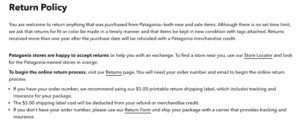
Refund Information
You should include information in your return policy about your refund protocols. Tell customers if they get full, partial, or no refunds on items they want to send back.
You should also mention if you offer store credit as a refund option. A good example comes from Walmart. They cover all refund information in the ‘How to get your refund’ clause in their return policy, pictured below.
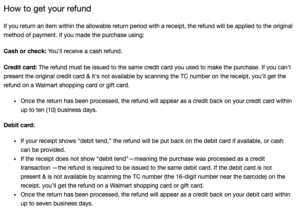
Exchange Information
You should tell customers if they can exchange items and, if so, under what conditions.
For example, you might offer clothing exchanges if someone needs a different size than what they originally ordered.
See how Patagonia explains exchanges to their customers in the screenshot below, which they keep separate from their return policy information.

You should also let your customer know if you only accept items for exchanges that still have tags, are in their original packaging, or have any other provisions.
Stipulations, Exclusions, and Warranties
Depending on the goods and services you sell, you might have stipulations, exclusions, or offer warranties on your items.
You’ll want to outline any stipulation for processes like refunding damaged goods or replacing incorrect items.
For example, in Casper’s return policy, they stipulate that items can be returned without original packaging, even if they’re already assembled, as seen in the highlighted text pictured below.

Be sure to mention geographical stipulations, like if your business operates in different regions and uses separate return policies based on customer location.
You might sell goods that are excluded from returns, so let your customers know if certain items are non-refundable, like swimwear or perishable items.
If you offer warranties on any products, clearly outline the guidelines and consider including a warranty disclaimer. Some businesses choose to include their warranty policy directly in their ecommerce terms and conditions.
Timeline
Let customers know how much time they have to request and follow through on a refund, return, or exchange. You should also include information about how long it will take for them to receive the refund or their exchanged item, like how Patagonia does it in the photo below.
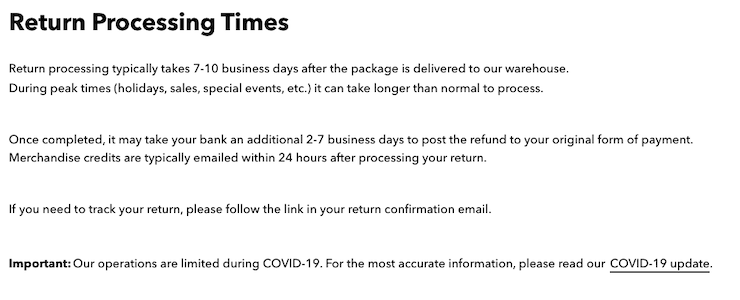
If COVID-19 affects your shipping times, you should also include that information in this section of your return policy, like Patagonia in the above example.
Shipping and Restocking Fees
Add a clause stating whether the customer or company is responsible for shipping and handling costs.
For example, in American Eagle’s return policy, they state that items that do not qualify for free returns result in a $5 charge.

Similarly, if you charge a restocking fee, include it in the policy. Many companies also make a separate shipping policy that goes in tandem with the return policy, and you can too with our free shipping policy template.
International Sales
If you sell to an international market, returns can get complicated. Familiarize yourself with regional laws in the areas where you do business, like the UK, where returns are legally mandated.
Amazon ships packages all over the world, so it makes sense for them to separate their information about international returns into its own policy, as seen below.
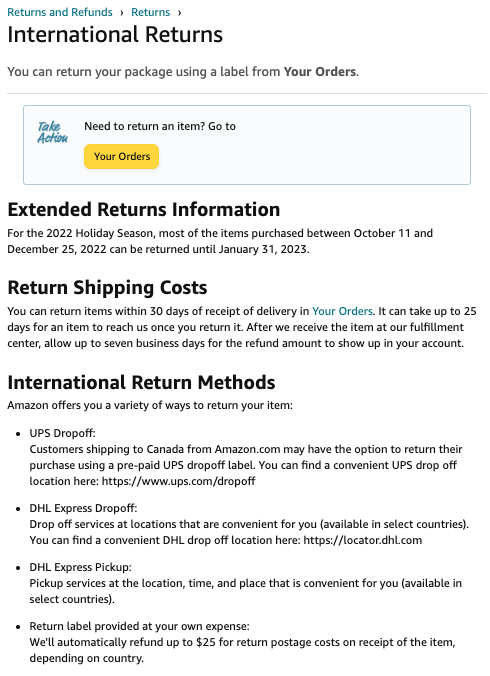
Other things to consider if you work internationally are shipping times and costs. For example, it may be easier for your business and the customer to provide a refund without receiving the item if shipping times to or from certain regions are prolonged.
Returns for Digital Products
For business owners selling digital products, you’ll want to establish a process for customer support if a download link is faulty. You should also state if you allow refunds on digital purchases.
Microsoft includes information about eligible returns and exclusions on digital products in their return policy within a small note.
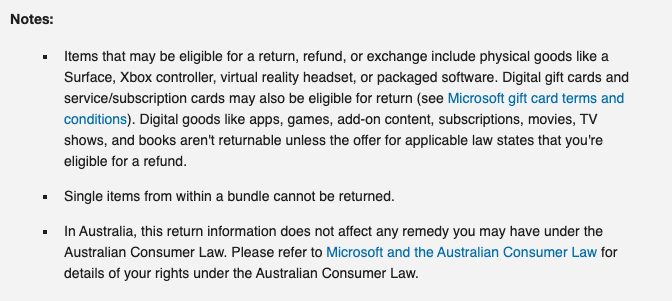
Where to Display Your Return Policy
You should display your return policy somewhere noticeable so new and returning customers can easily find it. It’s in your best interest to post your return policy in multiple locations.
Website Footer
The most common place for ecommerce stores to publish their return policy is in the footer of their website, so consumers can access it at any time while navigating through the site.
Check out Patagonia for an example of a return policy linked directly in the help section of the website footer.

During the Checkout Process
You might also want to display your return policy somewhere during the checkout process before a customer finalizes the sale, allowing them to read the procedure beforehand.
If needed, you can also point to the link if someone complains or tries to claim they could not find it. While customer reactions like this are rare, they do still happen, so it’s in the best interest of your company to be prepared.
In Other Legal Policies
Consider also including a link to your return policy within your terms and conditions agreement. Your refund policy is a condition of your services that users should be aware of if they want to purchase something from you, so it makes sense to include it in this policy.
In Your Emails to Customers
Include a link to your return policy in the footer of any emails you send to customers, especially if it’s a confirmation of purchase or shipment tracking email. Not only is this convenient for your consumers, but it also ensures they have knowledge about the return and refund protocols your company follows.
Physical Locations
At brick-and-mortar stores, return and refund policies are typically displayed near the cash registers, near the entrance and exit, and even in the fitting rooms.
Remember to look into regional laws that might dictate where you post a return policy in a physical store, like the US state regulations listed in the table above.
In Your Privacy Center
A great way to organize all of your legal agreements and privacy documents is by creating a privacy center on your website.
In your privacy center, you can include links to other helpful documents users should always have access to, like your return policy. It may not technically be a privacy document, but it’s still an agreement that you want your customers to always have access to.
Tips To Make the Most of Your Return and Refund Policy
A return policy is an essential document that can help you retain customers and build more trust between your business and your consumers.
Follow these easy tips so your company’s return policy stands out amongst the competition.
Make Your Return and Refund Policy Easy to Read
You want your return policy to be easy to read, and our guide on how to write a return policy can help you with that.
Avoid long paragraphs and unnecessary legalese, so your customers understand your company’s policies. It also makes it easier on yourself whenever you need to reference the return policy in the future.
You can always download our free Return and Refund Policy Template, which was designed by our legal team to be uncomplicated and straightforward.
Consider Avoiding a “No Refund” Policy
You can legally offer a no refund policy or a very similar all sales are final policy.
But many businesses with these strict policies lose customers to competitors with more lenient return options. “No refund” stipulations significantly impact online retailers because customers buy products sight unseen, which makes the risk of purchase higher.
Customers may also leave negative reviews about your policy or react angrily to your customer service department.
You might instead offer at least store credit, which could help you retain and appease a few of those customers.
Benefits of a Money-Back Guarantee Policy
A money-back guarantee incentivizes customers to complete the sale, especially if you’re an online retailer or sell digital products.
If you offer a no questions asked, full refund policy, it might set you apart from your competitors
It also builds trust between you and the customer and minimizes the risk new customers might feel purchasing from you for the first time.
Do Not Copy Someone Else’s Return Policy
No matter what, do not copy another business’s return policy. Not only is this plagiarizing, but you won’t know all facets of the policy.
It’s easy to create a comprehensive policy for your business using a refund policy template, many of which are free.
Return Policy Examples
While you should never copy another company’s return policy, it’s helpful to compare how other businesses handle specific stipulations and clauses to get ideas while building your own policy.
Let’s go over a few examples from larger retailers together.
American Eagle’s Return Policy
You’ve already seen us reference American Eagle’s generous return policy a few times on this page. They offer a full refund anytime with proof of purchase and store credit for items without a receipt.
To help customers find relevant answers they might have about this open-ended return policy, the company formats the bulk of the document in an easy-to-read, frequently-asked questions style.
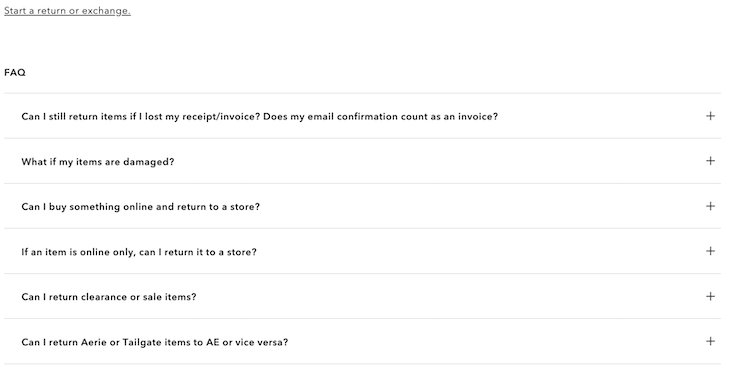
American Eagle also provides contact information in the header of their return policy, so customers can easily find a phone number, email, or live chat option for further support.
Target’s Return Policy
There might be certain products or services your company sells that are excluded from returns or exchanges. A great example return policy showcasing exclusions on returns comes from Target.
The big-box retailer informs customers about excluded items by providing a separate link in the return policy, as pictured below.

The blue link is easy to spot, making it convenient for customers.
Article’s Return Policy
Now we’ll look at the Article return policy for an example of how a furniture company handles exchanges for items without their original packaging.
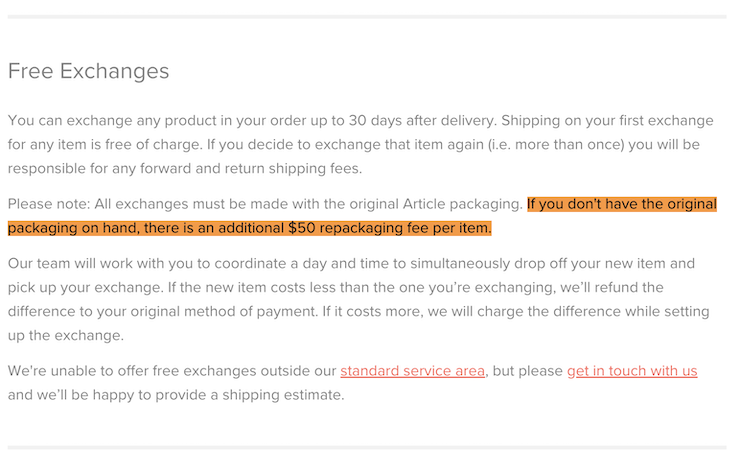
Like Article, you might need to charge different fees for returns or exchanges without their original packaging, especially if you sell large, fragile, or specialty items.
Now that you’ve looked at a few examples of a return policy, you can start building your own by downloading our sample return policy template below.
Return Policy FAQ
Got more questions? We have answers. Below are some of the most frequently asked questions we get about return and refund policies.
Are return and refund policies legally required?
No, return and refund policies aren’t legally required. But in the UK and most of Europe, you must offer returns and refunds for faulty, incorrect, or broken goods.
In certain US states, you are expected to provide consumers with a full refund for returned goods if you don’t post a return policy stating otherwise.
Which states require return policies?
Return policies are not required in any US state. But if you do not conspicuously post a policy stating that you intend to refuse returns in the following states, you are expected to provide the consumer with a full refund on returned goods:
- California
- Connecticut
- Florida
- Hawaii
- Maryland
- Massachusetts
- Minnesota
- New Jersey
- New York
- Ohio
- Rhode Island
- Utah
- Virginia
Do you have to have a return policy?
You do not have to have a return policy, but creating one is a business best practice. If you choose not to post one, you could be the victim of return fraud, and customers may react negatively or worry your company is unreliable.
You also will not have a place to direct consumers to if they have questions or concerns about returns, refunds, or exchanges.
Standard Return & Refund Policy Template (Free Download)
You can download our free return policy template below in Word Doc, PDF, or Google Doc format. You can also just copy & paste the HTML directly to your website.
Before using it, read through the entire return policy template – fill in all of the [brackets], remove any sections that do not apply to your app, and tweak any language as needed.
Refund & Return Template HTML
You can copy our return & refund policy template HTML code or download it using the options below.
Additional Template Download Options
Summary
If you sell products to consumers, your business should create a return policy that covers refunds and exchanges. A well-written return policy helps set your customers’ expectations, protects your company from liabilities, and resolves many customer service inquiries.
You don’t have to start this policy from scratch. Download our free Return Policy Template to customize a policy you can easily embed on your website or app in minutes.


